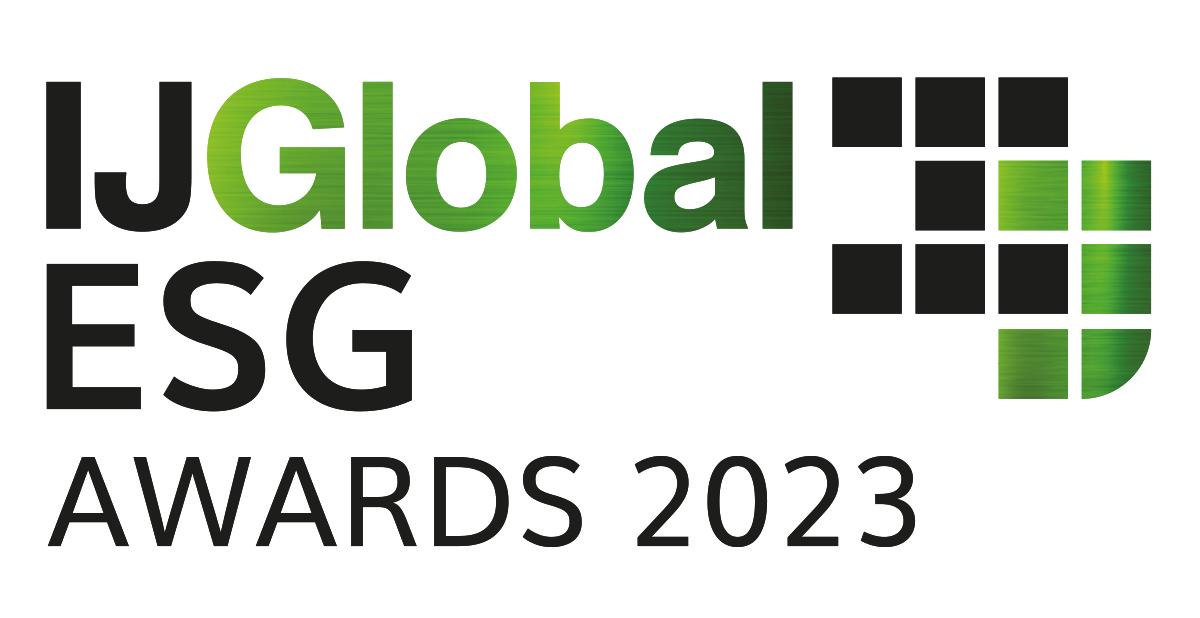IJGlobal ESG Infra & Energy Bank – Natixis
Natixis wins the IJGlobal ESG Infrastructure & Energy Bank award for 2023 with one of the judges recognising the transformative role it plays in energy transition saying its “Green Weighting Factor is a stand-out approach”.
Another of the independent panel of judges said: “Natixis has demonstrated clear impact and successful innovative methodological development.”

After almost 2 years of development, Natixis became the first bank worldwide to operationally launch a Green Weighting Factor (GWF) – a tool that goes way beyond mere reporting, directed at driving climate and environmental transition of the bank’s own balance sheet.
As the submission states: “The GWF is an in-house mechanism that links analytical capital allocation to the sustainability of each financing. By using this mechanism, Natixis allocates a degree of sustainability to each financing by considering both its climate benefits and climate risk exposure dimensions.
“Indeed, the tool helps to incentivise transactions that support the transition towards a low-carbon economy and penalise those financings with a strong negative impact on climate and the environment.
“As such, the GWF adjusts the perception of expected profitability of each transaction in line with its impact on the environment.”
The submission continues: “The bank’s GWF applies to Natixis CIB’s financing across all Infrastructure deals globally ahead of any credit decision, determining the ‘colour’ of each loan depending on the environmental impact of the object being financed.
“Under the mechanism, analytical risk-weighted assets (RWA) are reduced by up to 50% for green deals, while facilities that have a negative environmental and climate impact see their analytical RWA increased by up to 24%.
“The adjustment of the expected rate of return of each financing deal based on its environmental and climate impact provides a strong incentive for the bank’s teams to favour green financing when assessing deals with equivalent credit risk.”
And this internal regulation is important for Natixis given that Groupe BPCE – of which Natixis CIB is a subsidiary – has set its 2030 interim targets for the energy sectors.
The emission intensity of activities financed by Groupe BPCE in the power generation sector will be below 138 gCO2e/kWh by 2030. In addition, the group will by 2030 reduce by 30% the carbon emissions from the end-use of the oil and gas production activities it finances.
The submission states: “Natixis CIB has started factoring ESG risks into financing and investment activities as part of a global approach involving all business lines. The approach includes drafting and applying internal guidance and policies with regards to the most sensitive sectors when it comes to environmental impact.”
Natixis no longer finances coal-fired power plants and thermal mining around the world. It also pledged to no longer provide general-purpose corporate financing to companies for which coal-fired power plants or thermal coal mines account for more than 50% of their activity. The exit from coal was further accelerated by no longer supporting companies developing new coal-fired power plants or thermal coal mines, and to fully withdraw by 2030.
The French bank is prohibited from financing, investing and offering services to companies involved in manufacturing, storing, or trading anti-personnel mines and cluster bombs.
And on the natural resources front, it has commitment to no longer finance any shale oil and gas exploration and production projects, and no longer finance companies whose business is more than 25% based on the exploration and production of shale oil and gas.
Stating the case
Natixis makes strong statements in its submission, which won over IJGlobal’s independent panel of judges against strong competition.
It stated: “In the past financial year, Natixis CIB has truly established itself as a leading infrastructure house. Complete with fully integrated advisory teams across M&A, financing advisory, rating, sub-sector and financing, Natixis CIB provides access to all infrastructure equity investors in all corners of the world.
“What’s more, given its ability to design debt structures ahead of the equity process, the bank’s unique infrastructure debt platform allows for intimacy with infrastructure debt investors.
“The internal structures – namely the co-lending Square Platform and BPCE’s new debt fund – have strengthened Natixis CIB’s underwriting capabilities as well as increasing the bank’s capability to support clients with regards to both financing and advisory.
“More specifically, going forward, Natixis CIB is looking to further build on its initial success in Southeast Asia and to build on its first deals in Japan using its Natixis Tokyo branch booking capabilities.
“The bank is also looking to leverage its Korea branch to further develop relationships in the region and increase Korea-related business flow, such as ECA and real assets.
“As well as continuing to push in energy transition and renewable energy, this year will see the bank focus on sectors with emerging niches. Priorities for 2023 include digital infrastructure in Asia, and metals and mining in Indonesia and Australia, to name a few.”
Request a Demo
Interested in IJGlobal? Request a demo to discuss a trial with a member of our team. Talk to the team to explore the value of our asset and transaction databases, our market-leading news, league tables and much more.